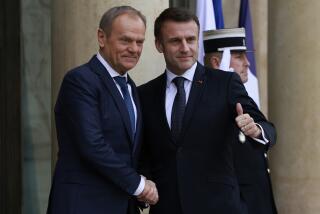Phantoms Haunt Paris Subway Stops
- Share via
PARIS — Talk in the streets is of a new Europe, a seamless superstate of common dreams. But down below, the No. 7 Metro rumbles from Tolbiac to Stalingrad, evoking 15 centuries of bitter conflict.
Phantoms of the past haunt present realities as 10 more states swell the European Union to 25 members in a merger of old Cold War enemies. It may take more than a single currency and catchall constitution to lay those ghosts to rest.
Each capital has its own historical references that prophesy hard work ahead in forging a single European identity. In Paris, the words of the prophets are written on the subway walls.
Station names like Stalingrad need little explanation. In living memory, 25 million people died on the Russian front because an Austrian-born megalomaniac tried to unite Europe under a German flag.
But Tolbiac?
“No idea,” said Martine Fillatre, whose wine shop faces the Tolbiac station. Given a hint -- history -- she brightened. “Oh, right. Vercingetorix. Gauls and Romans.” Not even close.
Vercingetorix is remembered at Alesia, on a different subway line, named for a brave but fruitless battle in 52 B.C. against Julius Caesar’s legions, which swept across France and settled in to stay.
Tolbiac was where Clovis, the Franks’ first king, seized Alsace from Germanic tribes in A.D. 496. In the historical continuum, Adolf Hitler’s Rhine campaign was just another round of an ancient struggle.
Depending upon how one counts, France and Germany have fought more than a dozen wars. Even now, when chances of another are beyond dim, the two continental giants are often at odds on national interests.
For optimists like Fillatre, a bold new European Union offers a chance to banish the old ghosts and bury ancient quarrels.
“I’m excited by the idea,” she said. “Just imagine, now we can all finally work together and build something new.”
Others are more cautious. Rene Pellet, in the southern city of Draguignan, saw friends shot while he served in the French Resistance against Germany. He has also read a lot of European history.
“It is encouraging that we can now live in peace,” he said. “That’s not bad for a start. But are we the same people as Germans? Or Poles? I don’t think so.”
For many, memories have yet to dim. Past Stalingrad, the No. 7 stops at Corentin Cariou. He was a Paris councilman shot when the Nazis decided to kill 100 Frenchmen for each German sniper victim.
Some names go back to Napoleon. Austerlitz in 1805 was his grand triumph over Austria and Russia. Rivoli sealed Italy’s fate. At Iena, he humbled the Prussians and, at Wagram, the Bavarians.
Elsewhere in Europe, old names recall Napoleon differently. The London-Paris train under the English Channel starts at Waterloo, named after the place where an English commander defeated Napoleon. It’s the station where Queen Elizabeth II boarded when she came to Paris in March to mark 100 years of the Entente Cordiale.
Berlin’s Alexanderplatz is named for the Russian czar who martialed forces against the Napoleonic legions that menaced an entire continent.
The idea of a single Europe is hardly new.
Voltaire, in 1751, saw “a kind of great republic divided into several states, some monarchical, the others mixed ... but all corresponding with one another.”
Rousseau, two decades later, wrote: “There are no longer Frenchmen, Germans, and Spaniards, or even English, but only Europeans.”
And in 1796, Edmund Burke pronounced, “No European can be a complete exile in any part of Europe.”
Statesmen have tended toward pragmatism. Otto von Bismarck, the 19th century unifier of Germany, dismissed a single Europe as an unworkable myth. Even Jean Monnet, the French visionary who began the process of European unification during the 1950s, said it had to start from scratch.
No Metro stop salutes Charlemagne, the Holy Roman emperor who made a single Europe a reality until 814. His base was not Paris but Aix la Chapelle. That is Aachen to Germans, who know him as Karl der Grosse, no Frenchman by any definition.
From Clovis to Charlemagne to Napoleon, anything approaching a united Europe was based on Christianity. Eighteen saints appear on the Paris subway map, not counting the odd cardinal.
But a short stroll in any direction from the Tolbiac station shows how the face of Europe has changed.
Past the corner McDonald’s, an Islamic butcher offers hallal meat. A smattering of noodle shops leads into an Asian quarter thick with Buddhists, Shintoists and Confucians.
Paris has 14 Metro lines, and each reflects a society that does not seem eager to dilute its flavor in any European melting pot. There is, for instance, the No. 1 line.
Among the busiest stops is the Bastille, stormed in the French Revolution in 1789. And there is also Nation, under what until 1787 was called the Place of the Throne. It was where kings entered Paris.
During the Revolution, the square was renamed Place of the Overturned Throne. Later, it became Nation. The bodies of 1,306 beheaded nobles are buried by the next station down the line, Picpus.
The No. 3 line stops in the heart of Paris, at a square built in 1826 to honor France’s greater neighborhood. That station is Place de l’Europe.
More to Read
Sign up for Essential California
The most important California stories and recommendations in your inbox every morning.
You may occasionally receive promotional content from the Los Angeles Times.













